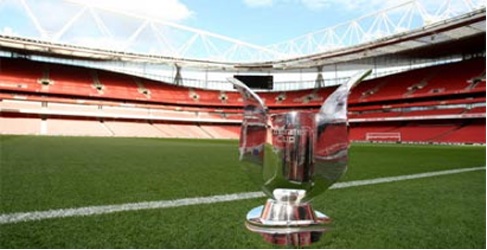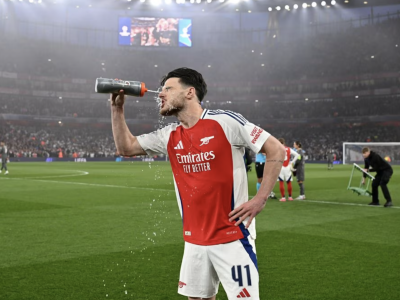(Ed’s note – For those that missed the first three instalments of this epic review, they can be viewed on the following links:
part one
part two
& part three
In August of 1996, Bruce Rioch had been stalling on signing his new contract for a little over a year, his position as Arsenal manager however was most probably considered even less tenable at this point than it had been before the pre-season fixtures commenced. On top of failing to land any additions to the squad, (other than former goalkeeper John Lukic as cover for David Seaman) after defeating St. Albans City 6-0 away from home in their opening pre-season fixture, Arsenal failed to win the following seven games (a run which included six defeats against Birmingham, Celtic, Rangers, Fiorentina, Benfica and Northampton Town), which obviously strongly hinted at discord within the camp.
After a 1-1 draw with Ipswich Town for John Wark’s testimonial, Bruce Rioch was dismissed by the Arsenal board. In stark contrast to their pre-season form however, by the time Arsene Wenger came to the club six weeks later Arsenal were sitting at the top of the Premiership – a fact which surprised most observers, who certainly didn’t think Stewart Houston and Pat Rice could hold the fort while Wenger saw out his contract with Grampus Eight. Though currently a divisive figure among the fans, it’s undoubted that after his appointment Wenger ushered in a new era at Highbury. At the very start of his first full season, an Arsenal side with signings such as Marc Overmars, Emmanuel Petit and Luis Boa Morte, alongside existing squad members such as Paul Shaw, saw off St. Albans City with a comprehensive 4-1 victory.
Wenger’s new style of Football also proved a hit with a global audience, as seen by this welcome which awaited the Arsenal squad on a visit to Thailand in 1999. Arsene Wenger’s Arsenal side would also receive an invite from Ajax for the newly reprised Amsterdam tournament in 2000. The club’s first appearance in this tournament came in 1979, where the club finished third. Arsenal’s return twenty one years on however saw them finish in last place, after losing 2-1 to a Barcelona side who had recently poached both Emmanuel Petit and Marc Overmars from Arsenal for a combined fee of £30 million. Arsenal’s goal was a well taken shot from Lithuanian trialist Tomas Danilevicius, who went on to make two other appearances that season against Sunderland on the opening day and a 5-3 home win against Charlton the following week. Arsenal were to taste defeat again 24 hours later, losing 2-0 to hosts Ajax.
Despite experiencing their best ever season in 2004, Arsenal were to finish in last place in that year’s Amsterdam Trophy again albeit on the back of two 0-0 draws with River Plate and Ajax (so actually remained unbeaten while still finishing last!). As you’re all well aware, Arsenal famously went the entire season before unbeaten sealing this achievement on 15th May 2004 and within forty eight hours of this feat took on an England XI for Martin Keown’s farewell testimonial, winning 6-0.
Despite obtaining the wooden spoon in 2004, Arsenal would go on to win three of the next four Amsterdam tournaments, sealing the 2005 trophy by beating the hosts 1-0 with a great finish from young Italian prospect Arturo Lupoli (whatever happened to him?) and then two Freddie Ljungberg goals saw off FC Porto in the final a day later. Though Arsenal didn’t compete in the Amsterdam tournament in 2006, that summer’s Amsterdam connection was retained through Dennis Bergkamp’s Testimonial becoming the first game to be played at our new ground.
The following season, the company who held the naming rights to our new ground would initiate their own tournament in a similar vein to Ajax’s with the very first Emirates Cup, which Arsenal went on to win beating Paris St. Germain and Inter along the way. Arsenal would however also return to the Dutch capital to reclaim the Amsterdam trophy with victories over Lazio and Ajax. Highlights of the inaugural Emirates Cup, that year’s Amsterdam trophy win and all other 2007/08 pre-season friendlies are captured here on this YouTube vid.
Arsenal came third in the Emirates Cup of 2008, losing 1-0 to Juventus though beating Real Madrid the following day. The Amsterdam tournament though was to remain in Arsenal’s possession, beating hosts Ajax 3-2 after trailing 2-0 with goals from Luis Suarez and Klaus Jan Huntelaar, securing the trophy a day later with a. 1-1 draw with reigning UEFA Cup holders, Sevilla Arsenal were to win the Emirates trophy back again in 2009, with wins over Atletico Madrid Atletico Madrid and a comfortable 3-0 win over Rangers, both games here commented on enthusiastically by Americans in a way you’d have never previously imagined with the Makita International tournament.
Arsenal’s last Emirates Cup triumph came a year later in 2010, drawing their first game against AC Milan 1-1 while defeating Celtic 3-2 the following day. Though now seen as Arsenal’s annual curtain raiser to the season (with the exception of 2012, where the tournament was deferred for one year because of the London Olympics), an Emirates Cup triumph has eluded them since 2010. The highlights in the meantime have been Thierry Henry’s return to Arsenal with New York Red Bulls in 2011 and four goals for Yaya Sanogo in a 5-1 demolition of Benfica where the BT Sport commentator memorably proclaimed Yaya to be ‘unstoppable’ just before he tripped over a microphone while running toward the crowd in celebration after bagging his fourth goal.
An interesting thing to observe from last year’s Emirates Cup footage however is that though the tournament is often derided as meaningless, there were few if any empty seats at the stadium in Ashburton Grove for Yaya Sanogo’s big moment in contrast to the sea of empty spaces for AC Milan’s game against Tottenham – and Arsenal’s 4-0 victory against our much maligned near neighbours the day before - in the Wembley International Tournament of 1988 as seen in yesterday’s article. Even taking into account that the national stadium held a bigger capacity in 1988 than Arsenal’s current stadium, the difference in capacity isn’t that great to justify the visible emptiness of some parts of the ground. The very same problem was visible with Arsenal’s Mercantile Credit Cup Final with Manchester United two months later at the much smaller Villa Park.
Despite the fact that these fixtures featured legendary names such as Paul Gascoigne, Bryan Robson, Mark Hughes, Ruud Gullit, Marco Van Basten, Frank Rijkaard, Paolo Maldini and Franco Baresi (the latter quintet were global stars on what was a very rare appearance in the UK), up against a ‘Champions Elect’ Arsenal side which itself contained a considerable amount of exciting young talent in one side, not seen since the days of the Busby Babes, they actually failed to sell out. What you see quite starkly see from this is that though modern football receives much in the way of criticism (as does the Emirates Cup with the cringe making Mexican waves which most of the day-trippers annually insist on), the demand for match day attendance in 2015 - even for ‘Mickey Mouse’ friendlies – self-evidently has sky-rocketed since the late 1980s.
Back in the mid to late-1980s many spoke of the ‘English disease’ which blighted our national game. When you take into account the fact that supply and demand is a huge factor behind inflation in the price of any commodity, it’s quite possible that paying £25 to see Arsenal line up against Nic Bendtner’s Wolfsburg (when we could have seen Gullit, Rijkaard and Van Basten for much less) might just have to be written off as a side-effect of twenty first century Football’s ‘disease of affluence’ – if that’s actually some consolation to you!
*Follow me on Twitter@robert_exley







